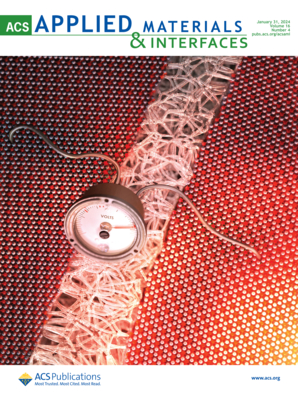An Expansion-Mitigant Binder for Stable Cycling of High-Loading Lithium–Sulfur Batteries
IF 8.3
2区 材料科学
Q1 MATERIALS SCIENCE, MULTIDISCIPLINARY
引用次数: 0
Abstract
Lithium–sulfur batteries with high sulfur content and mass loading are promising energy storage technologies due to sulfur’s exceptional theoretical energy density. However, in practice, their actual capacity drastically decays when the sulfur cathode is loaded to the commercially required levels of 4 mgsulfur cm–2 and above, significantly reducing the energy density. This reduction is due to the excessive formation of polysulfides during sulfur lithiation, which not only deteriorates battery performance through their detrimental shuttling but also results in substantial stress buildup due to their significantly larger volume compared to sulfur. To address these challenges, we have developed an approach to suppress lithium polysulfide shuttling by limiting the space for sulfur expansion while improving the Li+ ion diffusion. This was achieved through a straightforward but effective method to cross-link the organic binder used in sulfur electrodes. Specifically, PVDF, one of the most common binder materials for battery electrodes, was studied. The chemical, mechanical, and structural properties of the cross-linked PVDF binder were thoroughly investigated, compared with standard PVDF, and correlated to the achieved electrochemical performance of sulfur electrodes. As a result, sulfur cathodes with cross-linked PVDF binder exhibited prolonged cycle life compared to their standard counterparts. Moreover, using this expansion-mitigant binder, cathodes with areal sulfur loading of 4 mg cm–2 showed exceptional stability for more than 200 cycles and a Coulombic efficiency above 97%. This approach offers a promising avenue to alleviate the major roadblocks of lithium–sulfur battery commercialization while allowing the utilization of the commonly accessible and well-studied binder chemistries.

一种用于高负荷锂硫电池稳定循环的抗膨胀粘合剂
由于硫的理论能量密度极高,因此硫含量高、质量大的锂硫电池是一种很有前景的储能技术。然而,在实际应用中,当硫含量达到 4 mgsulfur cm-2 或更高的商业要求水平时,硫阴极的实际容量会急剧下降,从而显著降低能量密度。这种衰减是由于硫锂化过程中形成了过多的多硫化物,多硫化物不仅因其有害的穿梭作用而使电池性能下降,而且由于其体积比硫大很多而导致大量应力积聚。为了应对这些挑战,我们开发了一种方法,通过限制硫的膨胀空间来抑制多硫化锂的穿梭,同时改善 Li+ 离子的扩散。这是通过一种简单而有效的方法来交联硫电极中使用的有机粘合剂来实现的。具体来说,我们研究了 PVDF(电池电极最常用的粘合剂材料之一)。研究人员对交联聚偏二氟乙烯粘合剂的化学、机械和结构特性进行了深入研究,并与标准聚偏二氟乙烯进行了比较,还将其与硫电极的电化学性能进行了关联。结果表明,与标准阴极相比,使用交联聚偏二氟乙烯粘合剂的硫阴极具有更长的循环寿命。此外,使用这种膨胀改性粘合剂,硫的平均负载量为 4 毫克/厘米-2 的阴极在超过 200 个循环中表现出超强的稳定性,库仑效率超过 97%。这种方法为缓解锂硫电池商业化的主要障碍提供了一条大有可为的途径,同时还允许利用常见的、经过充分研究的粘合剂化学成分。
本文章由计算机程序翻译,如有差异,请以英文原文为准。
求助全文
约1分钟内获得全文
求助全文
来源期刊

ACS Applied Materials & Interfaces
工程技术-材料科学:综合
CiteScore
16.00
自引率
6.30%
发文量
4978
审稿时长
1.8 months
期刊介绍:
ACS Applied Materials & Interfaces is a leading interdisciplinary journal that brings together chemists, engineers, physicists, and biologists to explore the development and utilization of newly-discovered materials and interfacial processes for specific applications. Our journal has experienced remarkable growth since its establishment in 2009, both in terms of the number of articles published and the impact of the research showcased. We are proud to foster a truly global community, with the majority of published articles originating from outside the United States, reflecting the rapid growth of applied research worldwide.
 求助内容:
求助内容: 应助结果提醒方式:
应助结果提醒方式:


